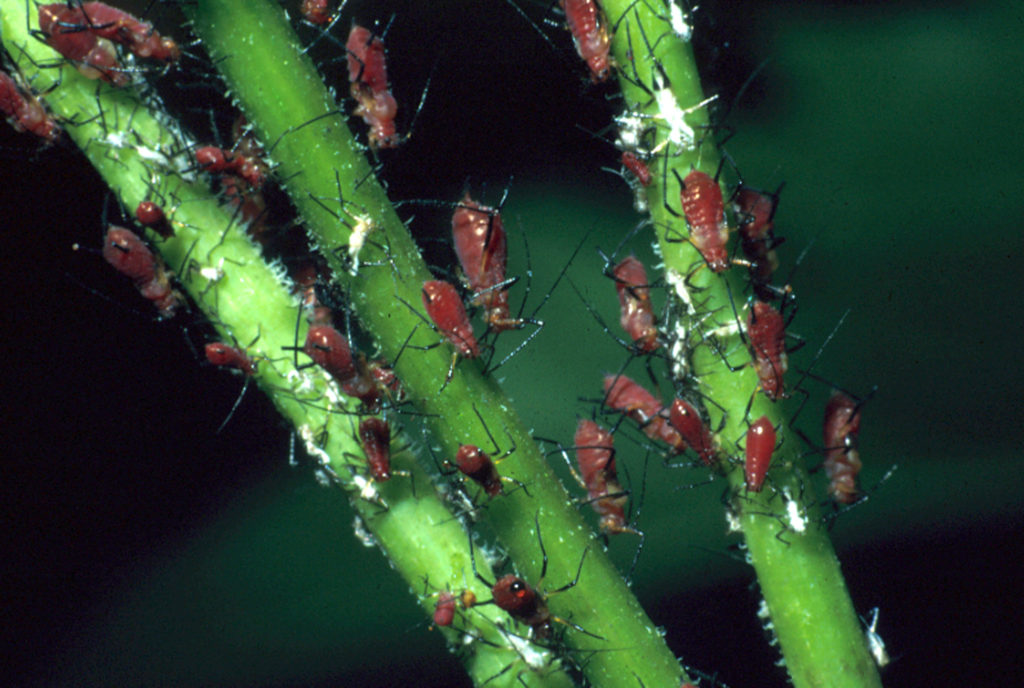What are aphids and what can you do about them?

In the popular children’s book “The Grouchy Ladybug” by Eric Carle, the tale begins with two ladybugs arguing over a plant covered with aphids. They both want to eat the tiny, green insects, but one ladybug — the grouchy one — refuses to share and instead flies away in a huff.
Thus the aphid, a common garden pest, has been introduced to many people at a young age.
From the book’s illustrations, children learn that aphids are small, round insects with spidery legs that gather in large numbers on plants. This is true, but there’s a lot more to aphids than that.
What are aphids?
Aphids are small (1/16 inch to ⅛ inch long) soft-bodied insects that suck sap from plants for sustenance, which can sometimes cause damage, especially if the aphid population is high. Known for being quick to multiply, aphids range in color from black to green to yellow, with different species of aphids living on different types of plants.
“There are many different species of aphids and many different kinds of plants aphids feed on,” said Jeffrey Hahn, entomologist for the University of Minnesota Extension. “Most plants have an aphid that feeds on it, though some [species of plants] are more commonly damaged by it.”
The best way to identify an aphid is to check for two “tailpipes,” or antennae-like protrusions known as “cornicles” found at the end of the abdomen, according to a resource on aphids written by Hahn and Suzanne Wold-Burkness for the University of Minnesota Extension. All aphids have cornicles, but some are smaller and less obvious.
In most cases, aphids cause little or no damage to the health of plants, however, a large population of aphids can remove enough sap from a plant to cause leaves to yellow, twist and curl. Aphids can also stunt the growth of a plant and cause parts of the plant to die.
In addition, when these insects feed, they produce and excrete a sticky, sugary substance called honeydew that can coat foliage, bark and objects beneath a plant — such as the windshield of a car parked under an aphid-infested tree. This sticky waste product can also develop sooty fungus, which gardeners find unsightly but doesn’t actually damage particularly damaging to plants.
Lastly, aphids can carry and transmit plant viruses that affects certain crops such as potatoes and squash.
What can you do about aphids?
Though aphids are generally viewed by gardeners as pests, they don’t always have to be eradicated.
“A lot of times aphids can be present without having any significant impact on the health of the plant,” Hahn said.
Aphid populations are often managed by their many natural predators, Hahn pointed out. These include parasitic wasps, lacewing larvae, hoverfly larvae and ladybugs. Hahn suggests that gardeners simply monitor plants for damage caused by aphids, then address any problems as the arise.
“You kind of have to eyeball it,” he said. “I think that’s a mistake sometimes people make. If they don’t monitor or watch closely enough, then all the sudden they look and they’re out of control.”
To search for aphid infestations, look underneath foliage, where the insects often congregate and feed. In addition, look for the sticky honeydew they create, which often attracts a variety of other insects, including ants.
“Aphids are common pests on roses. They really like the tender shoots. I always recommend knocking them off with a strong hose of water,” said Mary Lou Flint, entomologist for the University of California Extension.
It’s a simple solution that works, Flint said. Once knocked to the ground, aphids have a difficult time crawling back up the plant to re-establish their colony. However, because aphids multiply so quickly, you will need to continue to knock them off the plant with water from time to time.
Another management option is to spray the aphids with insecticidal soap or oil made specifically for that purpose. Applied directly to the aphids, these options usually don’t affect other insects.
“If you use the more toxic products, you’re going to kill a lot of beneficial insects, probably bees and other pollinators,” Flint said.
Hahn said that people sometimes create homemade soap solutions to spray on aphids, but he doesn’t suggest that. Often homemade solutions can burn the foliage of plants, he said.
Because many seedling vegetables are particularly susceptible to aphid damage, you can reduce losses by growing seedlings indoors or under protective covers, according to a resource on aphids written by Flint for the University of California Extension. Also before planting vegetables, check surrounding areas for aphids and remove them. Aphids often build up on weeds and move to crop seedlings after they emerge.
It’s homesteading skills month on Hello Homestead! Every weekday this month, we’ll be highlighting a skill for living a self-sufficient life. Make sure you LIKE our page on Facebook, FOLLOW on Twitter, FOLLOW us on Instagram and/or sign up for our newsletter so you don’t miss a single one!

[…] reason for the white fuzz covering on a tree could be that aphids have arrived. These insects are around two millimeters long and pink-brown and approximately two millimeters […]